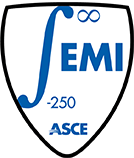Environmental Mechanics of Geomaterials
Duke University
Problems
Failure in many engineering systems including geo‐ systems occurs at mechanically subcritical states, after both long‐ and short time exposure to adverse environmental conditions. These conditions include elevated temperature, due to embedded infrastructural elements, such as nuclear waste canisters, high voltage cables, mined hot fluids and gases or energy storage structures; ground water causing dissolution of minerals, changes in the former due to ionic concentration, strength, electric charge, acidity evolution; both evaporation and condensation of pore fluid, to mention the few. Often such environmental variations are the effective cause of the mechanical failure of the aforementioned system. Effort is needed to improve our current poor understanding of both the critical variables, as well as the actual mechanisms, through which such variables are coupled to the mechanical soil material properties and variables, as well as inadequacy of computational methods that seriously impede our capability to assess the performance and predict service time of the affected geo‐structures.
Approach
We are developing in parallel both experimental data base and theoretical models that would allow us to identify the mechanisms of coupling between the mechanical properties of soils and chemical, thermal and physic‐chemical variables characterizing the (fluid and gas) soil environment, both external and internal. For instance, we have developed a method to experimentally capture and study gas entry mechanism into drying capillary grain system developing within 1/200th of second. On the theoretical side, we have developed models of micro DUKE chemo‐plasticity to deal with the effect of mineral dissolution on material damage of a grain.

Findings
One of our key findings in the area of pore space evolution during drying is that the change in the major pore size controls the material desiccation shrinkage in the stage of material saturation, and the corresponding suction defines the air entry event, via a criterion of water body failure near the soil body boundary. The subsequent partial saturation stage the major pores empty quickly and the minor pore size controls the suction, and imposes much smaller shrinkage rates.
Impact
Developments in the understanding of environmental impact on materials form a base for quantitative prediction of long‐term performance and durability of materials, including geomaterials and civil engineering structures and infrastructure. They allow us to explicitly include rates of chemical and geochemical reactions, physico‐chemical and transport processes into the models of mechanical processes of damage and irreversible deformation. They allow for a better assessment of degradation of geomaterials.
Core competencies
- Thermo-mechanics of soils
- Engineering of geological disposal of nuclear waste.
- Chemo-mechanics of geomaterials.
- Drying and cracking of soils.
- Sediment compaction.
- Mathematical modeling of behavior of complex soils
Current research team members
- Tomasz Hueckel (Professor)
- Rui Guo (Ph.D. candidate)
- Manman Hu (Ph.D. candidate)
Recent graduates and co‐workers
- Liang Bo Hu (now at the University of Toledo, Ohio)
- Herve' Peron (Ph.D. graduate from EPFL, Lausanne, Switzerland)
- Bolek Mielniczuk (Ph. D. - research associate at the University of Montpellier ‐ 2, France)
- Matteo Ciantia (Ph.D candidate at Politecnico di Milano, Italy)
Current research collaborations
- Lyesse Laloui (Professor at EPFL)‐ desiccation cracking
- Said El‐Youssoufi - capillarity evolution during drying (University of Montpellier ‐2)
- C. Di Prisco - degradation of calacernites (Politecnico di Milano) and R. Castellanza (U. of Milano‐ Bicocca)
- G. Cassiani and Giuseppe Gambolati ‐ sediment compaction (U. of Padua, Italy)


